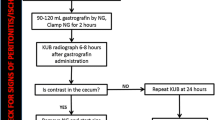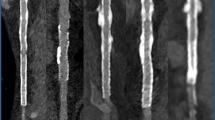Abstract
Background
Indocyanine green fluorescence imaging (ICG-FI) may be used to visualize intestinal perfusion prior to anastomosis. Methods for quantification of the fluorescence signal are required to ensure an objective evaluation. The aim of this study was to evaluate a method for quantification of relative perfusion and to investigate the correlation between the perfusion level and the anastomotic strength.
Method
This blinded, randomized, experimental trial included twenty pigs. Each pig received three small intestinal anastomoses with 30%, 60%, or 100% perfusion, respectively. The perfusion levels were determined relative to healthy intestine using ICG-FI. Ischemia was induced by mesenteric ligation and the perfusion level of each anastomosis was determined using a software-based analysis of the fluorescence signal. On postoperative day 5, the anastomoses were subjected to tensile strength test and histopathological assessment.
Results
No anastomotic leakage occurred. The tensile strength of the 30% perfusion group was 9.09 N, which was significantly lower than the 60% perfusion group (11.5 N) and the 100% perfusion group (12.9 N). The difference between the 60% perfusion group and the 100% perfusion group was not significant. The histopathological assessment showed no significant differences between perfusion groups.
Conclusions
A reduction in blood supply to 30%, as determined by ICG-FI, in small intestinal anastomoses was necessary to demonstrate a decrease in tensile strength.



Similar content being viewed by others
References
Matthiessen P, Hallbook O, Rutegard J, Simert G, Sjodahl R (2007) Defunctioning stoma reduces symptomatic anastomotic leakage after low anterior resection of the rectum for cancer: a randomized multicenter trial. Ann Surg 246:207–214
Platell C, Barwood N, Dorfmann G, Makin G (2007) The incidence of anastomotic leaks in patients undergoing colorectal surgery. Colorectal Dis 9:71–79
Karliczek A, Benaron DA, Baas PC, Zeebregts CJ, Wiggers T, van Dam GM (2010) Intraoperative assessment of microperfusion with visible light spectroscopy for prediction of anastomotic leakage in colorectal anastomoses. Colorectal Dis 12:1018–1025
Urbanavicius L, Pattyn P, de Putte DV, Venskutonis D (2011) How to assess intestinal viability during surgery: a review of techniques. World J Gastrointest Surg 3:59–69
Diana M, Agnus V, Halvax P, Liu YY, Dallemagne B, Schlagowski AI, Geny B, Diemunsch P, Lindner V, Marescaux J (2015) Intraoperative fluorescence-based enhanced reality laparoscopic real-time imaging to assess bowel perfusion at the anastomotic site in an experimental model. Br J Surg 102:e169–e176
Karliczek A, Harlaar NJ, Zeebregts CJ, Wiggers T, Baas PC, van Dam GM (2009) Surgeons lack predictive accuracy for anastomotic leakage in gastrointestinal surgery. Int J Colorectal Dis 24:569–576
Alander JT, Kaartinen I, Laakso A, Patila T, Spillmann T, Tuchin VV, Venermo M, Valisuo P (2012) A review of indocyanine green fluorescent imaging in surgery. Int J Biomed Imaging 2012:940585
Matsui A, Winer JH, Laurence RG, Frangioni JV (2011) Predicting the survival of experimental ischaemic small bowel using intraoperative near-infrared fluorescence angiography. Br J Surg 98:1725–1734
Diana M, Halvax P, Dallemagne B, Nagao Y, Diemunsch P, Charles AL, Agnus V, Soler L, Demartines N, Lindner V, Geny B, Marescaux J (2014) Real-time navigation by fluorescence-based enhanced reality for precise estimation of future anastomotic site in digestive surgery. Surg Endosc 28:3108–3118
Boni L, David G, Dionigi G, Rausei S, Cassinotti E, Fingerhut A (2016) Indocyanine green-enhanced fluorescence to assess bowel perfusion during laparoscopic colorectal resection. Surg Endosc 30:2736–2742
Jafari MD, Wexner SD, Martz JE, McLemore EC, Margolin DA, Sherwinter DA, Lee SW, Senagore AJ, Phelan MJ, Stamos MJ (2015) Perfusion assessment in laparoscopic left-sided/anterior resection (PILLAR II): a multi-institutional study. J Am Coll Surg 220(82–92):e81
Degett TH, Andersen HS, Gogenur I (2016) Indocyanine green fluorescence angiography for intraoperative assessment of gastrointestinal anastomotic perfusion: a systematic review of clinical trials. Langenbecks Arch Surg 401:767–775
Ris F, Liot E, Buchs NC, Kraus R, Ismael G, Belfontali V, Douissard J, Cunningham C, Lindsey I, Guy R, Jones O, George B, Morel P, Mortensen NJ, Hompes R, Cahill RA, Near-Infrared Anastomotic Perfusion Assessment Network V (2018) Multicentre phase II trial of near-infrared imaging in elective colorectal surgery. Br J Surg 105:1359
Wada T, Kawada K, Takahashi R, Yoshitomi M, Hida K, Hasegawa S, Sakai Y (2017) ICG fluorescence imaging for quantitative evaluation of colonic perfusion in laparoscopic colorectal surgery. Surg Endosc 31:4184
Nerup N, Andersen HS, Ambrus R, Strandby RB, Svendsen MB, Madsen MH, Svendsen LB, Achiam MP (2016) Quantification of fluorescence angiography in a porcine model. Langenbecks Arch Surg 403:881
Toens C, Krones CJ, Blum U, Fernandez V, Grommes J, Hoelzl F, Stumpf M, Klinge U, Schumpelick V (2006) Validation of IC-VIEW fluorescence videography in a rabbit model of mesenteric ischaemia and reperfusion. Int J Colorectal Dis 21:332–338
Carol Kilkenny WJB, Cuthill Innes C, Emerson Michael, Altman Douglas G (2010) Animal research: reporting of in vivo experiments. PLoS Biol 8:e1000412
Diana M, Noll E, Diemunsch P, Dallemagne B, Benahmed MA, Agnus V, Soler L, Barry B, Namer IJ, Demartines N, Charles AL, Geny B, Marescaux J (2014) Enhanced-reality video fluorescence: a real-time assessment of intestinal viability. Ann Surg 259:700–707
Coccolini F, Ansaloni L, Manfredi R, Campanati L, Poiasina E, Bertoli P, Capponi MG, Sartelli M, Di Saverio S, Cucchi M, Lazzareschi D, Pisano M, Catena F (2013) Peritoneal adhesion index (PAI): proposal of a score for the “ignored iceberg” of medicine and surgery. World J Emerg Surg 8:6
Armstrong G, Croft J, Corrigan N, Brown JM, Goh V, Quirke P, Hulme C, Tolan D, Kirby A, Cahill R, O’Connell PR, Miskovic D, Coleman M, Jayne D (2018) IntAct: intra-operative fluorescence angiography to prevent anastomotic leak in rectal cancer surgery: a randomized controlled trial. Colorectal Dis 20:O226
Diana M (2018) Fluorescence-guided surgery applied to the digestive system: the cybernetic eye to see the invisible. Cir Esp 96:65–68
van Manen L, Handgraaf HJM, Diana M, Dijkstra J, Ishizawa T, Vahrmeijer AL, Mieog JSD (2018) A practical guide for the use of indocyanine green and methylene blue in fluorescence-guided abdominal surgery. J Surg Oncol 118:283
Koyanagi K, Ozawa S, Oguma J, Kazuno A, Yamazaki Y, Ninomiya Y, Ochiai H, Tachimori Y (2016) Blood flow speed of the gastric conduit assessed by indocyanine green fluorescence: new predictive evaluation of anastomotic leakage after esophagectomy. Medicine (Baltimore) 95:e4386
Frasson M, Flor-Lorente B, Rodriguez JL, Granero-Castro P, Hervas D, Alvarez Rico MA, Brao MJ, Sanchez Gonzalez JM, Garcia-Granero E, Group AS (2015) Risk factors for anastomotic leak after colon resection for cancer: multivariate analysis and nomogram from a multicentric, prospective, national study with 3193 patients. Ann Surg 262:321–330
Kjaer M (2019) Collagen and biomechanics in early surgical wound healing. University of Copenhagen Faculty of Health Sciences, Copenhagen
Ikeuchi D, Onodera H, Aung T, Kan S, Kawamoto K, Imamura M, Maetani S (1999) Correlation of tensile strength with bursting pressure in the evaluation of intestinal anastomosis. Dig Surg 16:478–485
Bosmans JW, Jongen AC, Bouvy ND, Derikx JP (2015) Colorectal anastomotic healing: why the biological processes that lead to anastomotic leakage should be revealed prior to conducting intervention studies. BMC Gastroenterol 15:180
Thompson SK, Chang EY, Jobe BA (2006) Clinical review: healing in gastrointestinal anastomoses, part I. Microsurgery 26:131–136
Diana M, Noll E, Diemunsch P, Moussallieh FM, Namer IJ, Charles AL, Lindner V, Agnus V, Geny B, Marescaux J (2015) Metabolism-guided bowel resection: potential role and accuracy of instant capillary lactates to identify the optimal resection site. Surg Innov 22:453–461
Hoeppner J, Crnogorac V, Hopt UT, Weiser HF (2009) The pig as an experimental model for colonic healing study of leakage and ischemia in colonic anastomosis. J Investig Surg 22:281–285
Acknowledgements
The authors are grateful to Paola Saccomandi, Alfonso Lapergola, and Pernille Øhlenschläger Larsen for their contribution to data collection.
Funding
Michele Diana is the recipient of a grant (ELIOS project, www.fondation-arc.org) from the ARC foundation for cancer research (9 Rue Guy Môquet, 94803 Villejuif, France). The VR-Perfusion software was partly developed in the framework of the ELIOS project.The project was partly funded by a grant (34-A1806) from Odense University Hospital Free Research Fund.
Author information
Authors and Affiliations
Corresponding author
Ethics declarations
Disclosures
Jacques Marescaux is the President of the IRCAD and IHU Institutes, partly funded by Karl Storz, Siemens Healthcare and Medtronic. Karl Storz was NOT involved in study design nor data acquisition/interpretation. Drs. Kristina Gosvig, Signe Steenstrup Jensen, Niels Qvist, Troels Steenstrup Jensen, Vincent Agnus, Veronique Lindler, Michele Diana, Mark Bremholm Ellebæk have no conflicts of interest or financial ties to disclose.
Additional information
Publisher's Note
Springer Nature remains neutral with regard to jurisdictional claims in published maps and institutional affiliations.
Rights and permissions
About this article
Cite this article
Gosvig, K., Jensen, S.S., Qvist, N. et al. Remote computer-assisted analysis of ICG fluorescence signal for evaluation of small intestinal anastomotic perfusion: a blinded, randomized, experimental trial. Surg Endosc 34, 2095–2102 (2020). https://doi.org/10.1007/s00464-019-06990-w
Received:
Accepted:
Published:
Issue Date:
DOI: https://doi.org/10.1007/s00464-019-06990-w




